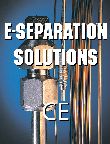Ask the Editor: GC Resolution Loss
The answer to the following reader question about resolution loss in a GC analysis was supplied by LCGC's "GC Connections" columnist John Hinshaw.
The answer to the following reader question about resolution loss in a GC analysis was supplied by LCGC’s “GC Connections” columnist John Hinshaw.
I am working on terpenoid composition study of an essential oil–bearing plant using a polyethylene glycol–coated stationary phase capillary column with a Varian model CP-3800 gas chromatography (GC) system. I use two wide-bore capillary columns: 30 m x 0.32 mm x 0.25 µm film thickness CP-WAX 52 CB and DB-WAXetr.
My problem is that after every 30 sample injections, the retention time starts shifting and continues to shift as more runs are made. As a result of this shift, I lose peak-to-peak resolution and column replacement is the only option available to me to obtain the right resolution. I have tried to revive the resolution by by cutting 1 m of length from both ends of the column, but this requires method validation and restructuring of the method.
I start every morning by making a blank run using a developed column oven program. I use diethyl ether as the washing solvent. My GC system includes a split–splitless injector along with a flame ionization detector. Further, I strictly follow all the instructions provided by the manufacturer, including temperature limits for isothermal and temperature programmed experiments, before starting analysis on above listed columns. I change the injector septum on the regular basis.
What is causing this loss of resolution?
You may be contaminating the front of your column with nonvolatile components from the plant extract. It may be possible to rinse the contamination from the column, but this requires a solvent that dissolves the contaminants while not dissolving or disturbing the stationary phase. Instead, you might try adding a retention gap between the inlet and the beginning of your column. A retention gap is a 1–3 m piece of uncoated deactivated fused-silica tubing that acts as an extension to the inlet that receives and holds contaminants before they can enter the analytical column itself. You will find references to retention gaps in most GC column manufacturers’ catalogs along with various types of zero-dead-volume fittings for making the retention gap to column connection.
The addition of a retention gap of the same internal diameter as the analytical column should have little or no effect on GC performance. You still should validate the combination of column and retention gap to be sure that the separation and resolution, as well as the unretained peak time, flow rate, and pressure drop, remain within prescribed limits.
After it has been contaminated, the retention gap can be replaced with a fresh one. This will require removing only 1–2 cm or so from the beginning of the analytical column to expose a clean end for the new retention gap connection. The impact on the performance will be minimal, in terms of changing column dimensions, by retaining 99.9%+ of the analytical column length for each retention gap replacement.
You also should change the inlet liner and install a new one whenever you replace the retention gap.
A second area to investigate is the preparation of your samples. Perhaps you can adjust the procedure to remove more of the unwanted interfering compounds.
Questions?
LCGC technical editor Steve Brown will answer your technical questions. Each month, one question will be selected to appear in this space, so we welcome your submissions. Please send all questions to the attention of "Ask the Editor" at lcgcedit@lcgcmag.com We look forward to hearing from you.

Determining Neurotransmitters in Spinal Cords with UHPLC
February 18th 2025Researchers at Jilin University (Changchun, China) developed a highly sensitive, rapid, and accurate method for analyzing neurotransmitters (NTs) in rat spinal cord tissue. Ultra-high performance liquid chromatography-triple quadrupole tandem mass spectrometry (UHPLC-QqQ-MS/MS) in conjunction with ultra-ionic liquid dispersive liquid-liquid microextraction (UA-MIL-DLLME) were used to extract NTs for analysis.
The Next Frontier for Mass Spectrometry: Maximizing Ion Utilization
January 20th 2025In this podcast, Daniel DeBord, CTO of MOBILion Systems, describes a new high resolution mass spectrometry approach that promises to increase speed and sensitivity in omics applications. MOBILion recently introduced the PAMAF mode of operation, which stands for parallel accumulation with mobility aligned fragmentation. It substantially increases the fraction of ions used for mass spectrometry analysis by replacing the functionality of the quadrupole with high resolution ion mobility. Listen to learn more about this exciting new development.
Revolutionizing LC-MS with Next-Gen Separation for Cyclic Peptide Analysis
February 17th 2025Cyclic peptides, known for their stability and high specificity, are promising therapeutic agents in the fight against cancer, infections, and autoimmune diseases. However, developing effective cyclic peptides presents numerous challenges, including poor pharmacokinetics, efficacy, and toxicity. Traditional methods like liquid chromatography tandem-mass spectrometry (LC-MS/MS) often struggle with resolving isomeric linear peptide metabolites, posing significant risks in safety, efficacy, and regulatory approval. In this paper, Komal Kedia, PhD, will share how she leveraged MOBIE’s high-resolution ion mobility-mass spectrometry (IM-MS) system to achieve a 72% reduction in run times, 200% greater resolving power, and enhanced accuracy in identifying “soft spots” prone to enzymatic degradation.











